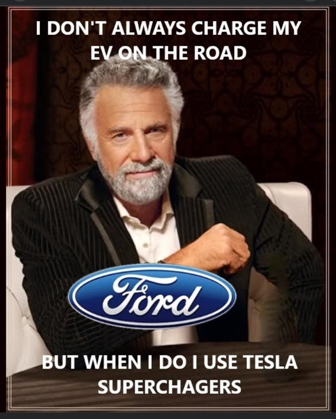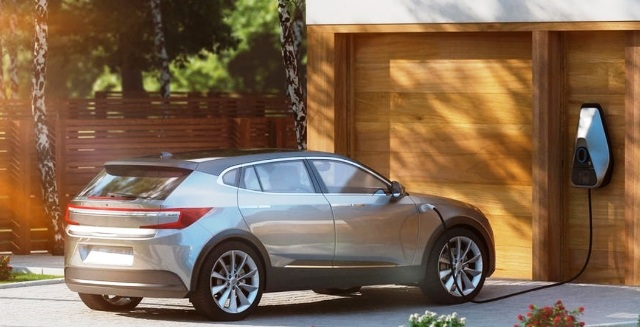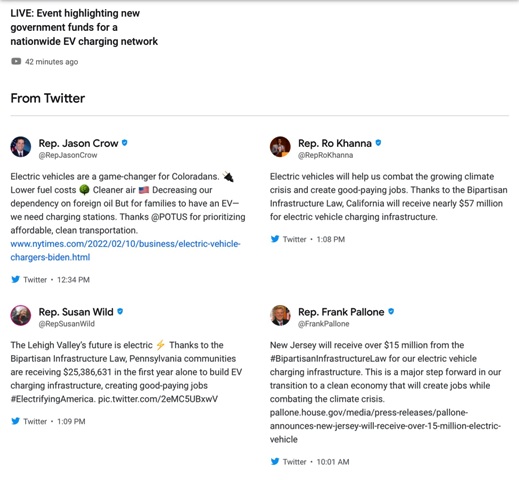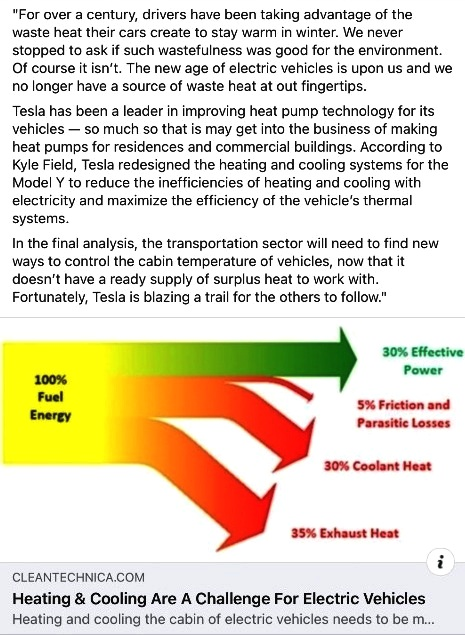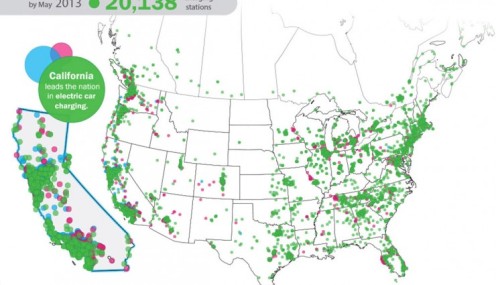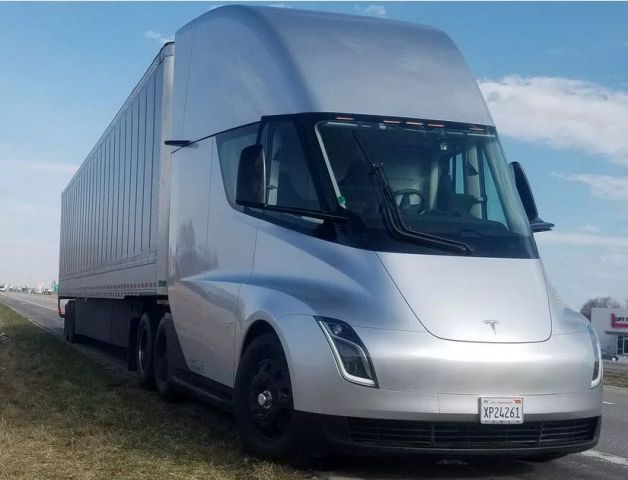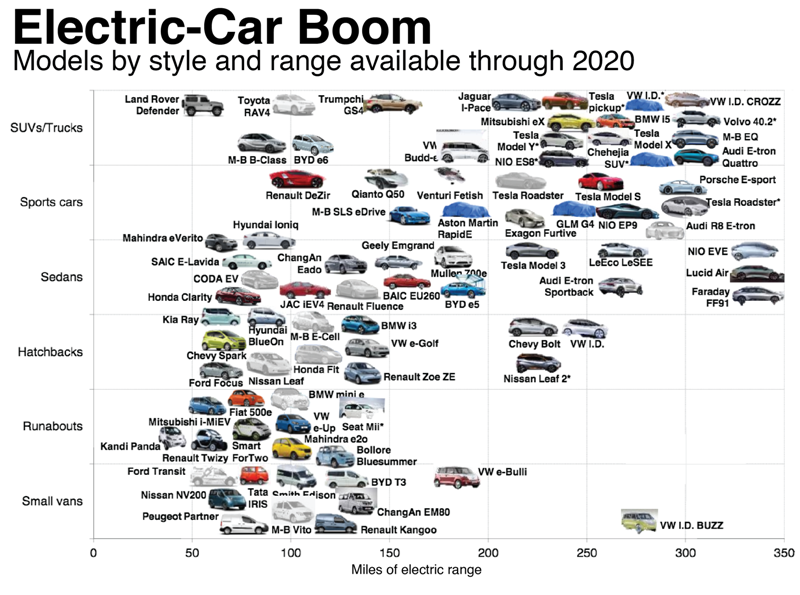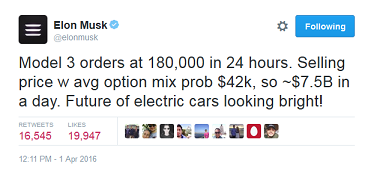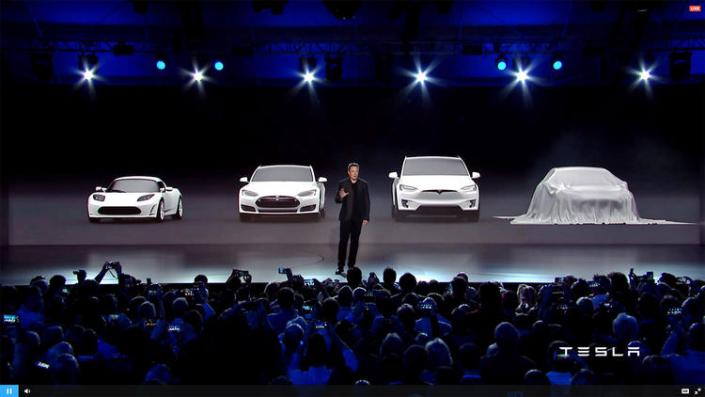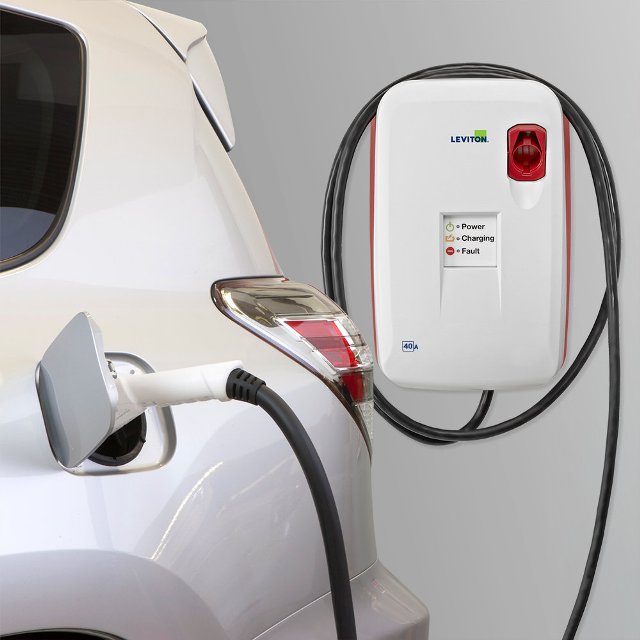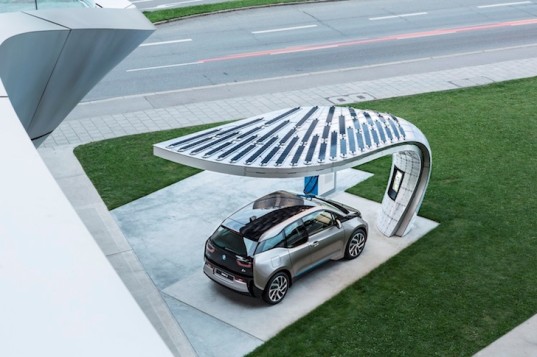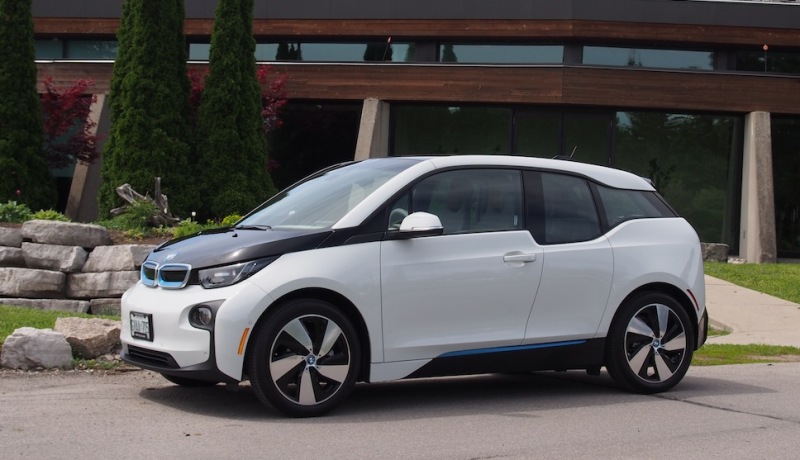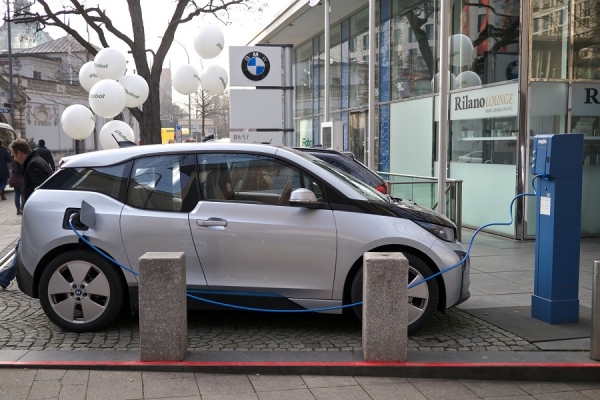EV Corridors Electric Vehicles Zero Emission Vehicles
2023
EV Battery Challenges Include Supply-Side
For EVs to fulfill their clean-energy promise, they need to avoid repeating the mistakes of the first Industrial Revolution. Miners and manufacturers can embrace cleaner ways to get the materials they need, and recover more of what they use.
Slow Rollout of US National Charging System
Lawmakers approved $5 billion for states to build a network of fast chargers two years ago. Although some states have made progress in recent weeks, most have not yet awarded contracts or started construction
~
EV Trucks, They're on the Road and More Are on the Way
Via Teslarati / September 28, 2023
Run on Less EV trucking study with a 1,000-mile trek
Three-week event that assessed the performance of 21 electric trucks.
The event was geared toward helping gain an in-depth understanding of both the advantages and challenges of EV trucking as the commercial sector begins to adopt sustainable Class 8 vehicles more proactively.
The Semi was the keynote vehicle, and three units were to be assessed during the event, along with several other commercial vehicles, including Ford E-Transit vans, a Freightliner Cascadia, a Volvo VNR, and a GM BrightDrop.
One of the more impressive tallies through the event was given by the Semi when it trekked 794 miles in one day and followed it up with a similar performance the following day, accounting for 1,600 miles of logistics in just two travel days for the Semi. In terms of local routes, this is impressive.
································································································································
How Much Does It Cost to Charge an Electric Vehicle?
What does a kilowatt-hour cost, how does EV home charging compare versus gasoline?
On the road, it's more complicated due to many options, factors, and e-charging providers
September 2023
Calculating the cost of charging an electric vehicle, at home and on the road, can be complicated. For the four out of five new-car buyers who can charge at home, often overnight, the cost per mile is virtually always cheaper than the cost of gasoline for a similar vehicle. It's tougher for apartment dwellers, who may pay a variety of rates to companies that operate charging stations in shared parking areas. For DC fast-charging, which a driver will likely want to use on road trips that are longer than an EV's range, prices vary, but are often roughly in line with gasoline prices.
Because of these factors, the price of a full charge can vary considerably. For a Tesla Model Y, currently the bestselling EV, it could cost as little as $9 or as much as $40, depending on whether you're charging at home or at a far more expensive Level 3 fast-charger.
To look at best and worst cases, Car and Driver picked 3 EVs that span a range: from small to large, from relatively efficient to huge and power hungry. They looked at the highest and lowest home-charging rates, which can vary among states by a factor of almost four. And they calculate the cost of DC fast-charging for a road trip...
················································································
EV Batteries Lasting Longer Than Expected
- Study Data Surprises
Headlines: General Motors drivers will be able to use Tesla's Supercharger network
··········································································································································
Industry-changing: Ford Taps Tesla Chargers in Partnership Between Rivals
Ford drivers will be able to use Tesla's Supercharger network
May 2023
Ford Stock Rides Tesla EV Partnership To Best Day Since October
Tesla shares surged into the holiday weekend—tacking on nearly the entirety of Ford's market cap.
Tesla, Ford announce partnership on Superchargers
Ford's deal with rival Tesla Inc. gives its electric-vehicle customers access to the Tesla Supercharger network, a move toward a single industry standard to simplify recharging.
Ford electric vehicles (EV) gain access to Tesla's electric car chargers starting next year, the companies announced Thursday. In a Twitter Spaces livestream, Tesla CEO Elon Musk and Ford CEO Jim Farley announced Thursday the partnership on Superchargers between the two companies.
Ford EVs will use Tesla charging tech in surprise partnership between rival automakers
Under the agreement current Ford owners will be granted access to more than 12,000 Tesla Superchargers across the U.S. and Canada, starting early next year.
Ford CEO Jim Farley on new Ford-Tesla EV partnership: It's a bet for our customers.
Tesla Inc.'s partnership with Ford Motor Co. on electric-vehicle charging technology is winning support across Wall Street.
Ford EV owners in the US can use the Ford's mobile app to use Tesla's 12,000 Supercharger stations, the company's name for its fast charging stations, starting next year, announced Ford CEO Jim Farley and Tesla CEO Elon Musk.
Tesla is the No. 1 EV maker in the U.S., selling 1.31 million vehicles in 2022. Ford is the No. 2. EV maker, selling 61,575 last year.
Tesla will bring its Supercharger network to Ford, a competitor in the EV market, to help bring the car company to 'equal footing,' Elon Musk said.
"It's super exciting to be in a partnership with Ford, I have a lot of respect for Ford as a company and it makes great vehicles," Musk said.
Two Charging Companies Respond To Ford’s Adoption Of The Tesla/NACS Plug
Via CleanTechnica
May 27, 2023
Yesterday’s announcement that Ford’s future vehicles would be equipped with Tesla’s NACS charging connector (Supercharging port) signaled a big shift in the industry. Before the announcement, Tesla was using its plug and everyone else was using the CCS1 plug in the United States. It seemed like this would continue indefinitely, as manufacturers of both vehicles and charging equipment have been using CCS for years. So, the Ford announcement wasn’t just one company’s decision, but possibly a break in the dam holding Tesla’s plug back from further adoption in the industry.
Two Charging Players Have Responded
First, here’s a statement from Electrify America: “Electrify America, the nation’s largest open ultra-fast charging network, is built on the widely adopted SAE Combo Charging System (CCS-1) standard. Over 26 automotive brands utilize the CCS-1 standard today. Since our founding, we have focused on building an inclusive and open Ultra-Fast charging network to facilitate the adoption of electric vehicles (EV). Since 2020, we have experienced a 20-fold increase in charging sessions. In 2022, we delivered over 5.2 million successful charging sessions and 173 gigawatts-hours of electricity, while continuing to open new stations and replace early technology chargers with our latest generation. Electrify America was also the first to introduce the standards-based Plug & Charge in North America, allowing for a seamless charging experience across multiple vehicles.
“As the EV charging infrastructure landscape continues to evolve, we continue to monitor market demand and government policies. Electrify America is committed to being a part of the broader charging solution for EV drivers today and in the future.” ...
FreeWire Energy, the maker of EV charging stations with integrated battery storage (also responded). “FreeWire commends the recent announcement by Tesla and Ford to make NACS charging accessible to more vehicles. For a sustainable transition to electric transportation, it is crucial to quickly increase investments and make reliable, publicly accessible fast-charging infrastructure widely available. It will require all charging providers to work together to meet public charging demand, and we support Tesla in making steps towards opening their technology and network. FreeWire has long been a proponent of standardization across the industry as it will make charging more convenient for drivers and allow infrastructure to keep pace with EV adoption nationwide. FreeWire plans to make NACS connectors available on Boost Chargers by mid 2024.” ...
(I)f the Tesla/NACS plug does overtake the industry, FreeWire and Electrify America appear willing to follow the industry down that path as needed to keep their companies going.
(The) take away from these first responses is that the industry is trying to be flexible, and that should be good news for everybody. Not only does it mean there’s room for better solutions to be implemented, but it also means innovation and competition won’t get driven out of the industry.
·················································································
Bipartisan Infrastructure Law (BIL)
- Charging and Fueling Infrastructure Discretionary Grant Program
The BIL establishes a Charging and Fueling Infrastructure discretionary program to strategically deploy publicly accessible electric vehicle charging infrastructure, hydrogen fueling infrastructure, propane fueling infrastructure, and natural gas fueling infrastructure along designated alternative fuel corridors or in certain other locations within communities that will be accessible to all drivers of electric vehicles, hydrogen vehicles, propane vehicles, and natural gas vehicles.
- https://www.fhwa.dot.gov/environment/alternative_fuel_corridors/
- https://www.fhwa.dot.gov/bipartisan-infrastructure-law/fact_sheets.cfm
- https://www.fhwa.dot.gov/bipartisan-infrastructure-law/technical_support.cfm
Publicly available charging stations
March 2023
Non-Tesla electric vehicles can officially start fueling up at Tesla Supercharger stations in the US.
On Feb. 28, Tesla announced that select stations had been fitted with adapters for other brand EVs, and drivers in California, Texas, New York and other states have reported using them successfully.
Earlier in February, the White House issued guidance that EV manufacturers who wanted to receive federal funding had to make their chargers brand-agnostic. That same month, Tesla announced a plan to open at least 3,500 Superchargers to other vehicle.
(Background) In 2021, a $1.2 trillion infrastructure bill set aside $7.5 billion to create a network of 500,000 public EV chargers by 2030, mostly on high-traffic highways and in densely populated residential areas.
Tesla is among the companies financing the project, with a combination of private money and federal subsidies.
S&P Global Mobility estimates that, as of January 2023, there were nearly 17,000 Superchargers and Tesla destination chargers in the US.
March 14
The U.S. Department of Transportation announces it is accepting applications to fund EV charging and fueling infrastructure projects across the country.
The first round of Charging and Fueling Infrastructure (CFI) Discretionary Grant program funds will provide $2.5 billion over the next five years to cities, counties, local governments, and tribes. The funding makes up to $700 million from fiscal years 2022 and 2023 available to strategically deploy EV charging and other alternative vehicle-fueling infrastructure projects in publicly accessible locations in urban and rural settings, as well along the Alternative Fuel Corridor (AFC).
“Extending EV charging infrastructure into traditionally underserved areas will ensure that equitable and widespread EV adoption takes hold,” U.S. Secretary of Energy Jennifer M. Granholm said. “Ensuring that charging stations are more visible and accessible in our communities addresses the concerns many American drivers have when considering making the switch to electric.”
The CFI grant program would build on the $5 billion National Electric Vehicle Infrastructure (NEVI) Formula Program and would further the Biden Administration’s goal of building a national network of 500,000 public EV charging stations and reducing national greenhouse gas emissions by 50 to 52 percent by 2030.
“By helping bring EV charging to communities across the country, this Administration is modernizing our infrastructure and creating good jobs in the process,” U.S. Transportation Secretary Pete Buttigieg said. “With today’s announcement, we are taking another big step forward in creating an EV future that is convenient, affordable, reliable, and accessible to all Americans.”
The funding is divided into two grant funding categories – the Community Program, which provides $1.25 billion to deploy EV charging infrastructure and hydrogen, propane, or natural gas fueling infrastructure in communities, and the Corridor Program, which provides $1.25 billion to deploy EV charging infrastructure and hydrogen, propane, and natural gas fueling infrastructure along designated alternative fuel corridors (AFCs). The charging stations may be located on any public road or in other publicly accessible locations.
“FHWA is committed to helping towns and cities, large and small, build modern, sustainable infrastructure that promotes equity and opportunity for their local economies and net-zero emissions for the nation by 2050,” Federal Highway Administrator Shailen Bhatt said. “By encouraging the adoption and expansion of EV charging and alternative fuels, CFI Program investments have the potential to significantly address the transportation sector’s outsized contributions to climate change.”
S&P Global Mobility estimates there are about 126,500 Level 2 and 20,431 Level 3 charging stations in the United States today, plus another 16,822 Tesla Superchargers and Tesla destination chargers. The number of chargers has grown more in 2022 than in the preceding three years combined, with about 54,000 Level 2 and 10,000 Level 3 chargers added during 2022.
S&P Global Mobility registration data shows that there are 1.9 million electric vehicles (EVs) in operation today, or 0.7% of the 281 million vehicles in operation, as of October 31, 2022.
Supporters of vehicle electrification point to the more than 140,000 EV charging stations currently deployed across the United States - including Level 2 AC and Level 3 DC fast chargers and both public and restricted access units - as a sign that a budding system to support our transportation transformation is in place. (as of January 2023)
Charging Definitions
AC Level 1: What most people will have in their homes, and equivalent to a 110v wall outlet. Would require 20 hours to fully recharge an EV.
AC Level 2: Equivalent to an upgraded home charger that uses a 208-240 volt circuit (used for an electric clothes dryer) and usually requires a 50-amp breaker for each charger. Takes about five hours to fully recharge an EV. Often also seen in shopping centers.
DC Level 3 Fast Charging: Requires a much larger grid connection to convert the AC current to DC. An EV's battery management system must be able to handle the rapid flow of electricity - currently as high as 350 kW. Takes 15-20 minutes to recharge most DCFC-ready vehicles from 10% to 80% state of charge.
Tesla Supercharging: Can add about 200 miles of range to a Tesla vehicle in 15 minutes. Tesla has offered converters to other brand vehicles for use in its Superchargers in Europe, with plans for US adaptation in the works.
Source: EVgo | https://www.evgo.com/
○
2022
December 2022
US Postal Service to buy 66,000 electric vehicles to transform fleet
USPS Intends To Deploy Over 66,000 Electric Vehicles by 2028, Making One of the Largest Electric Vehicle Fleets in the Nation
August 2022
California out in front in a Green future
California Acts to Ban the Sale of New Gasoline Cars
The decision, to take effect by 2035, will very likely speed a wider transition to electric vehicles because many other states follow California’s standards
After the California Air Resources Board approved Thursday regulations that ban the sale of new gas-engine vehicles by 2035, requiring all new cars to run on electricity or hydrogen, California Gov. Gavin Newsom told ABC News he was confident that more states would do the same to help combat climate change.
BY THE TIMES EDITORIAL BOARD | AUG. 26, 2022
It’s hard to overstate the significance of California’s move this week to end the sale of new gas-powered cars.
The California Air Resources Board’s vote Thursday setting a firm 2035 deadline is huge and consequential for climate change, air quality and health. The nation’s most populated and worst-polluted state is the first to adopt rules that will finally stop adding gas-fueled passenger vehicles to its roads.
The end of the internal combustion engine era, and the toll on our lungs and our planet, is finally on the horizon.
This regulation will require automakers to sell increasing percentages of zero-emission and plug-in hybrid vehicles starting with 35% of new car sales in 2026, reaching 68% in 2030 and 100% by 2035. Zero-emission vehicles account for 16.5% of California’s new sales today, a rate that leads the nation but lags behind Europe and China. So these rules help reestablish California’s climate leadership, putting it in step with other leading nations and making it one of the first — and the largest — vehicle markets in the world to require 100% of new sales be zero emissions.
It’s a pivotal moment for a state that has been shaped for decades, often negatively, by automobiles and the health-damaging pollution they generate.
More on California's decision to drive forward into a new world of transportation
- ~
○
CNBC Interview: Exxon CEO says no new gas cars globally by 2040
Via Electrek -- CNBC
June 26, 2022
- https://www.cnbc.com/2022/06/25/exxon-mobil-ceo-all-new-passenger-cars-will-be-electric-by-2040.html
Every new passenger car sold in the world will be electric by 2040, according to Exxon Mobil CEO Darren Woods, in an interview aired this weekend by CNBC.
The interview also covered the company’s climate ambitions, putting a flashy coat of paint on an organization that is the world’s 5th largest historical polluter and has pushed climate denial at a high level for half a century.
Exxon Mobil CEO Darren Woods sat down with CNBC’s David Faber for a long interview about climate change. The full interview is 35 minutes long (on top of a previous hour-long interview) and mostly discusses climate change and Exxon’s carbon capture and storage desires....
○
The oil giant is predicting that by 2040, every new passenger car sold in the world will be electric, CEO Darren Woods told CNBC’s David Faber in an interview. In 2021, just 9% of all passenger car sales were electric vehicles, including plug-in hybrids, according to market research company Canalys. That number is up 109% from 2020 says Canalys.
In light of its modeling, Woods said Exxon Mobil is evaluating how the decline in gasoline sales could impact its business. Exxon Mobil is one of the largest publicly traded international gas companies and a leader in the industry. Its website boasts that it is the largest “refiner and marketer of petroleum products,” as well as a chemicals company.
Woods, who spent a part of his career on the chemical side of the company’s operations, says chemicals will be key to keeping the company profitable during the clean energy transition. The plastics that Exxon Mobil produces can be used in the manufacturing of electric vehicles.
ExxonMobil’s calculations predicted that oil demand in 2040 would be equivalent to what the world needed in 2013 or 2014. Woods explained to CNBC that the company was still profitable at that time.
Woods seemed unfazed by the prediction, saying “that change will not make or break this business or this industry quite frankly.”
○
Going Green: You Want to Go Electric?
- Here's a Database of Latest EV Green Info... Get Going, Be Green, Go Green!!
Charge Across Town
Charge It!
EV Database
Electric for All
Electric Vehicle for Sale in the US
- Electric Vehicles for Sale Soon in the US
EV Adoption: All EVs currently available in the US
Federal (US) Tax Credits for All-Electric & Plug-in Hybrid Vehicles
Global Drive to Zero
Green Cars
Greener Cars
InsideEVs: Monthly Sales & Lease Deals
PlugStar: EV 'Shopping Assistant'
Rent a Tesla at Hertz
○
2021
Joint Office of Energy and Transportation .... DOT & DOE Step Up with EV Charging Infrastructure Nationwide
Electric vehicle charging stations: As U.S. pushes shift, where should chargers be placed?
○
Plug-in cars are the future, the U.S. electric grid isn’t ready
By 2035, the chief automakers will have turned away from the internal combustion engine. It’ll be up to the grid to fuel all those new cars, trucks and buses.
○
New EV Engineering Challenges: Heating & Cooling
○
EV Road Trip Competition
- https://www.businessinsider.com/tesla-ev-electric-car-ford-mach-e-road-trip-charging-problems-2021-9
Check it out... Tech YouTuber Marques Brownlee ran an experiment to find out what's better for a road trip: a traditional gas-fueled car or an electric vehicle.
The 1,000-mile test exposed how much time charging an EV adds to a long journey. But it also highlighted a major edge Tesla has over other companies building battery-powered vehicles.
Brownlee and his team got three vehicles for a two-day road trip around New York State: a gas-fueled Audi Q5, a Tesla Model S Plaid, and a Mustang Mach-E, Ford's electric SUV. They all started from the same point with a full tank or battery. The goal was to compare how long it took each vehicle to make the trip.
○
Why Electric Cars Will Take Over Sooner Rather Than Later
"We are in the middle of the biggest revolution in motoring since Henry Fords' first production line ... in 1913"
Every Electric Vehicle That's Expected in the Next Five Years
○
Infrastructure: The American Jobs Plan
Via Car and Driver
https://www.caranddriver.com/news/a36017463/biden-23-trillion-infrastructure-plan-electric-cars/
Officially known as the American Jobs Plan, President Biden's plan includes $174 billion to promote electric vehicles and EV charging stations, $80 billion for public transit, and another $80 billion for railroads.
Construction and upkeep for traditional infrastructure items—highways, bridges, and roads, for example—get $115 billion in the proposal.
EV fans are unsurprisingly excited, calling this a "down payment on the future of transportation," and expect private investment to follow federal dollars.
When we look at the $620 billion in transportation spending that's included in the plan, as the Wall Street Journal did, it's clear that electric vehicles will benefit the most thanks to $174 billion in spending, including incentives to buy EVs and support to get more EV chargers installed across the country: 500,000 of them by 2030.
... The $174 billion in support of electric vehicles is getting the most attention from connected players in the auto industry, of course.
"To fully understand the investment in electric transportation that the President is proposing, we need to appreciate the vast scope of the challenge," Joel Levin, executive director of EV advocacy group Plug In America, said in a statement. "This federal investment of $174 billion is really intended to activate all of the private human and financial capital that will be needed and is just a fraction of the real cost for this transformation. This is a down payment on the future of transportation."
Pasquale Romano, president and CEO of EV charging station operator ChargePoint, said the government money will stimulate private sector investment in EV charging infrastructure throughout the U.S.
"We encourage Congress to pass legislation that supports the proposed plan and includes rebates to businesses that will accelerate the installation of charging infrastructure for multifamily homes and workplaces," he said in a statement, adding that Congress should expand tax credits to support fleet electrification and fund charging infrastructure on U.S. highways.
○
President Biden hopes to build 500,000 new electric car chargers
- The US could have 35 million EVs by 2030, requiring millions of plugs where the country only has 100,000
○
EV Chargers are where the action is
Jim Cramer went wild tonight (January 26, 2021) about the upside of the EV Charging Stocks.
The EV charging 'space and sector' ... the EV charging companies are the future, now, and he pushed the charger stocks.... Climate Real Impact & EVgo ... Switchback & Chargepoint ... TPG & EVBox ....
Cramer says EV is huge and accelerating. 'Ford has an EV strategy, GM is turned their company-wide strategy to EV. The Euro and Japanese, Chinese car manufacturers are racing to keep up.
With GM announcing its future vehicle production will be all electric by 2035, the charge to power the EV fleets is now....
With the new U.S. president Joe Biden signing a "Buy America" executive order, and highlighting his support for renewable energy, Biden said "The federal government also owns an enormous fleet of vehicles, which we're going to replace with clean electric vehicles made right here in America, by American workers."
The fleet of government-owned vehicles numbered 645,000 as of 2019, according to U.S. General Services Administration (GSA) data cited by Reuters.
>EVBox owns Europe's largest EV charging station network, and has a total of over 200,000 charging ports in more than 70 countries worldwide. It also has a North American headquarters in Libertyville, Illinois, and recently brought its latest-generation charging stations to the U.S. and Canada. A buildout of stations in the U.S. could certainly benefit the company. It is for this reason that Cramer said he'd suggest buying shares in TPG Pace Beneficial. "If you want a charging station play, EVBox seems like the best of the bunch," Cramer said on his show.
EVgo focuses on the specific niche of DC fast chargers (DCFCs) in the U.S., and currently has 50% market share, according to the company. These stations are best suited for commercial applications where consumers are on the go, such as shopping or dining.
TPG Pace Beneficial Finance (NYSE:TPGY), which will be bringing EVBox public, were 15.3% higher. Climate Change Crisis Real Impact I Acquisition (NYSE:CLII), which is combining with EVgo, saw its shares rise 11.7%. Shares of Blink Charging (NASDAQ:BLNK) also jumped 18.7%.
○
US National Alternative Fuel Corridor program reaches thru the Southwest
- Three states to go to complete 50 state map / 2020
○ ○ ○ ○ ○ ○ ○ ○ ○ ○ ○ ○ ○ ○ ○ ○
Electric Vehicle Corridors (US)
In the US the expansion of EV charging infrastructure is starting to hit its stride, as shown by the efforts of companies like Electrify America, ChargePoint, and EVgo.
Rolling, Rolling, Rolling, EVs Are Rolling, Electric Trucks Next Up ...
• More Charging Stations Needed Due to More Electric Vehicles on the Roads
• Charging Corridor System (as of 2018)
• Tesla Supercharger Stations Map
In the U.S., the world’s second-largest producer of greenhouse gases, transportation makes up the largest share of emissions.
Plugging in cars and trucks is a critical national challenge. How far has the U.S. progressed in its move to electric vehicles and transportation networks?
EV Charging in China and the United States, Models for National Planning
○ ○ ○ ○ ○ ○ ○ ○ ○ ○
US Congress House Transportation Committee in Action / 2019
US National/State/Local / Transportation Challenges & Opportunities / News
National plans for electric-car charging corridors
- • The U.S. Department of Transportation will establish 48 electric-vehicle charging corridors along national highways that cross 35 states and cover almost 25,000 miles
- • A total of 28 states, electric utilities, carmakers, and other organizations have committed to accelerate charging infrastructure along these corridors
- • The Administration will partner with 24 state and local governments to add more plug-in electric vehicles to their fleets
- • Two separate Department of Energy studies are underway to determine optimal scenarios for deploying national electric-car charging infrastructure
- • The existing DoE Workplace Charging Challenge has gained 38 new members, among them businesses, universities, electric utilities, and nonprofit organizations
Advancing America's 21st Century Transportation Network
- With the designation of alternative fuel corridors, the Federal Highway administration is establishing a national network of alternative fueling and charging infrastructure along national highway system corridors.
EV Trucks / Freight / Semi Electric / Light-Duty, Medium-Duty, Heavy-Duty
Local Transportation / Regional / National
Future of EV Highway Systems
• February 2018 / FedEx orders Tesla Semi electric trucks
• January 2018 / Volvo to Go after Tesla's Semi in 2019
Transport Topics / December 2018
As electric vehicle technology becomes increasingly viable for commercial trucking, fleets and manufacturers are now putting the first generation of battery-electric trucks on the road.
The introduction of electric-powered trucks represents the industry’s first steps toward a future beyond the internal combustion engine. It also marks perhaps the biggest change in trucking equipment since the motor vehicle replaced the horse and carriage.
Electric vehicles represent a path to zero-emission trucking and huge fuel savings for fleets ... applications will be limited at first, and several hurdles remain for adoption.
Early models are designed primarily for shorthaul applications such as urban pickup and delivery, refuse trucks and port drayage.
Opportunities for regional routes... are next, followed at some point by longhaul operations. Battery technology will need to continue to improve to reduce weight and extend vehicle range.
The industry also will need to establish adequate charging infrastructure to support these vehicles.
○
• 2016 / Electric Truck Overview — Electric Light-Duty Trucks, Medium-Duty Trucks, & Heavy-Duty Trucks
• June 2015 / Making Trucks More Efficient Isn't Actually Hard to Do
○ ○ ○ ○ ○ ○ ○ ○ ○ ○ ○ ○ ○ ○ ○ ○
Going Green, Alt-Energy
December 2015 / Public Law No: 114-094
Renewable Energy and Electric Vehicles
Sec. 151. National electric vehicle charging and hydrogen, propane, and natural gas fueling corridors
(a) ... the Secretary shall designate national electric vehicle charging and hydrogen, propane, and natural gas fueling corridors that identify the near- and long-term need for, and location of, electric vehicle charging infrastructure, hydrogen fueling infrastructure, propane fueling infrastructure, and natural gas fueling infrastructure at strategic locations along major national highways to improve the mobility of passenger and commercial vehicles that employ electric, hydrogen fuel cell, propane, and natural gas fueling technologies across the United States.
(b) Designation of Corridors - In designating the corridors... the Secretary shall --
(1) solicit nominations from State and local officials for facilities to be included in the corridors;
(2) incorporate existing electric vehicle charging, hydrogen fueling, propane fueling, and natural gas fueling corridors designated by a State or group of States; and
(3) consider the demand for, and location of, existing electric vehicle charging stations, hydrogen fueling stations, propane fueling stations, and natural gas fueling infrastructure.
(c) Stakeholders - In designating corridors under subsection (a), the Secretary shall involve, on a voluntary basis, stakeholders that include--
(1) the heads of other Federal agencies;
(2) State and local officials;
(3) representatives of--
(A) energy utilities;
(B) the electric, fuel cell electric, propane, and natural gas vehicle industries;
(C) the freight and shipping industry;
(D) clean technology firms;
(E) the hospitality industry;
(F) the restaurant industry;
(G) highway rest stop vendors; and
(H) industrial gas and hydrogen manufacturers; and
(4) such other stakeholders as the Secretary determines to be necessary.
(d) Redesignation- Not later than 5 years after the date of establishment of the corridors under subsection (a), and every 5 years thereafter, the Secretary shall update and redesignate the corridors.
(e) Report- During designation and redesignation of the corridors under this section, the Secretary shall issue a report that--
(1) identifies electric vehicle charging infrastructure, hydrogen fueling infrastructure, propane fueling infrastructure, and natural gas fueling infrastructure and standardization needs for electricity providers, industrial gas providers, natural gas providers, infrastructure providers, vehicle manufacturers, electricity purchasers, and natural gas purchasers; and
(2) establishes an aspirational goal of achieving strategic deployment of electric vehicle charging infrastructure, hydrogen fueling infrastructure, propane fueling infrastructure, and natural gas fueling infrastructure in those corridors by the end of fiscal year 2020.'.
○ ○ ○ ○ ○ ○ ○ ○ ○ ○ ○ ○ ○ ○ ○ ○ ○ ○ ○ ○
Interstate Transportation / Infrastructure News
April 2016
Former Senator Jeff Bingaman of New Mexico and Chairman of the Senate Energy and Natural Resources Committee from 2001 to 2003 and 2007 to 2013 is appointed to the National Infrastructure Advisory Council by President Obama.
July 2015
The National Infrastructure Advisory Council makes three overarching recommendations to address these findings. In short, we need to
- 1) baseline current risks and establish a Federal vision for transportation resilience;
- 2) develop the analytic tools, models, and exercises to better understand and plan for emerging risks and interdependencies; and
- 3) use the results of these efforts to operationalize resilience by increasing funding and implementing effective Federal practices, procedures, and procurement processes.
Illinois Announces First Ever Charging Station Network for Route 66 Electric Corridor
New Charging Stations to Help Expand Illinois’ Sustainable Transportation System
CHICAGO – Nov. 28, 2014 – Governor Pat Quinn today announced an investment of $1 million to establish a network of charging stations for electric vehicles along historic Route 66 through Illinois. The network will support commuter and tourist driving for the growing electric vehicle (EV) sector. Today’s announcement is part of Governor Quinn’s agenda to drive Illinois toward a sustainable future.
“We are building a 21st century infrastructure across Illinois and we need to make sure that it is sustainable for future generations,” Governor Quinn said.
“This new project exemplifies Illinois’ place as the innovation capital of the Midwest, with cutting-edge business practices that create jobs and encourage sustainability.”
The state has joined local governments and the private sector to create the Illinois Route 66 Electric Corridor, a partnership that connects communities along the 300-mile stretch from Lake Michigan to the Mississippi River in the Metro East area with a network of high-power EV charging stations. The network will make it possible for EV drivers to travel between Chicago and St. Louis, two of the key urban markets for EVs in the nation.
The cities of Plainfield, Dwight, Pontiac, Normal, Lincoln, Springfield, Carlinville and Edwardsville will each install one or more fast charging stations that are easily accessible from historic Route 66, allowing EV drivers to retrace its original pathway. Each of the seven charging points in the network will include one fast charging station capable of charging vehicles with either CHAdeMO or SAE connectors within 15-20 minutes and one level 2 (240/120 volt) charging station. Installation of the charging stations will begin this month, with targeted completion by summer 2015.
The project is supported by auto manufacturers, including BMW, Illinois-based Mitsubishi and Nissan, which is contributing the charging station to be installed in Edwardsville.
"The State of Illinois' Route 66 EV corridor is consistent with Mitsubishi Motors North America's desire to affect a broader acceptance of EVs through user-friendly infrastructure," MMNA General Manager of Corporate Communications Dan Irvin said. "It is our belief that projects like this will help our state maximize the possibilities of EVs."
“Residents and visitors alike will soon be able to enjoy the sites, attractions and mystique of the state’s Historic Route 66 with easy access to charging stations for their electric vehicles,” Illinois Department of Commerce and Economic Opportunity Director Adam Pollet said. “It’s truly an electrifying addition to the ‘mile after magnificent mile’ to be discovered in Illinois.”
The University of California - Davis, one of the world’s leading universities on sustainable transportation, provided technical assistance for project planning.
“Illinois has one of the better combinations of price and carbon emissions per kilowatt-hour of electricity in the nation,” Gustavo Collantes, with the UC Davis Policy Institute and lead of the Zero Emission MAP initiative, said. “This infrastructure has the clear potential to save drivers money while delivering environmental benefits to the state and the nation.”
-=-=-=-=-=-=-=-=-=-=-
Further Information:
http://www3.illinois.gov/PressReleases/ShowPressRelease.cfm?SubjectID=2&RecNum=12880
http://www.route66news.com/2014/11/30/auto-chargers-coming-route-66-illinois/
http://energy.gov/sites/prod/files/2014/04/f14/2013_amr_01.pdf
Route 66, the 'Mother Road' http://www.nps.gov/nr/travel/route66/index.html
○ ○ ○ ○ ○ ○ ○ ○ ○ ○ ○ ○ ○ ○ ○ ○
Multi-state ZEV plans
http://www.oregon.gov/ODOT/HWY/OIPP/docs/Multi-State_ZEV_ActionPlan.pdf
http://www.govtech.com/transportation/Eight-Governors-Sign-Electric-Vehicle-Promotion-Pact.html
○ ○ ○ ○ ○ ○ ○
EV Sales
March 2016
Elon Musk wows with newly unveiled Tesla Model 3, nets 133,000 pre-orders and counting
Musk: The car represents the culmination of a long-held dream to bring affordable, zero-pollution vehicles to the world's highways.
With CO2 levels and global temperatures at record highs, the Model 3 will help bring engineering solutions to the climate change problem.
○ ○ ○ ○ ○ ○ ○ ○ ○ ○ ○ ○ ○ ○
Electric/EV Info
(added chronologically)
EV Sales Blog - http://ev-sales.blogspot.com/
Insider EVS - http://insideevs.com/monthly-plug-in-sales-scorecard/
Green Car Reports - http://www.greencarreports.com/news/electric-cars
EV Connect - EV Together
EV Travel Charging / Corridor Maps
Charging locations
http://www.plugshare.com/ (mobile)
https://itunes.apple.com/us/app/plugshare/id421788217?mt=8 (iOS app)
https://play.google.com/store/apps/details?id=com.xatori.Plugshare&hl=en (Android app)
○ ○ ○ ○
http://en.wikipedia.org/wiki/Charging_station
○
http://www.westcoastgreenhighway.com/electrichighways.htm - West Coast Green Highway
http://www.theevproject.com/charging-maps.php - The EV Project
http://www.energy.ca.gov/2015publications/CEC-600-2015-015/CEC-600-2015-015.pdf - Corridor Fast Charging in California
http://inhabitat.com/tesla-supercharging-stations-enable-effortless-travel-from-la-to-new-york/ (2014)
http://inhabitat.com/google-maps-now-indicates-electric-vehicle-charging-stations - Google Maps News, EV Charging Locations - (2011)
http://www.pev4me.com/find-public-charging-stations-for-your-electric-car-using-the-plugshare-app/ - Find Your EV Plugshare(2012)
○
What if you could charge your car from photovoltaic solar panels fitted to the roof of your home?
http://www.wired.com/2014/10/envision-solar-ev-charger/ - Back to the beginning of solar power for car charging (2014)
- https://www.revisionenergy.com/at-home/electric-vehicle-charging/
- http://www.post-gazette.com/business/2014/07/25/Mall-at-Robinson-unveils-new-solar-powered-car-charging-stations/stories/201407250036
- http://www.greencarreports.com/news/1079733_electric-car-solar-panels-are-they-right-for-you
Getting Millions of Zero Emission Cars on the Road By 2025
- UC Davis Initiative Playing a Key Role in Multi-State Action Plan
A UC Davis project to accelerate the market adoption of zero emission vehicles (ZEVs) was highlighted in a recently-released plan to get 3.3 million advanced, clean cars in eight states on the road by 2025. ZEVs include battery-electric, plug-in hybrid and fuel cell electric vehicles.
Zero Emission Market Acceleration Partnerships (ZE MAP), a project of the UC Davis Policy Institute for Energy, the Environment and the Economy, Institute of Transportation Studies (ITS-Davis), and Plug-In Hybrid & Electric Vehicle Research Center (PH&EV Center), has been providing technical assistance since last fall to state and local governments working to expand ZEV adoption. Eight of those states – California, Connecticut, Maryland, Massachusetts, New York, Oregon, Rhode Island and Vermont – released a multi-state ZEV Action Plan in May 2014...
http://www.nescaum.org/topics/zero-emission-vehicles
The ZE MAP was launched last fall at a meeting with nearly 50 key leaders from state and municipal governments across the nation pledging to work together on critical strategies to build the market. Participants described their activities, highlighted successes and outlined challenges they face with supporting and implementing market introduction and advancement of these advanced clean cars.
ZE MAPPING was created to provide technical support to groups such as eight states working to implement a multi-state Action Plan. Participation in ZE MAP goes beyond those eight states -- more than 20 governmental entities are benefiting from leading-edge accessible data, analysis and expertise that UC Davis brings to the ZE MAP with its 25 years of interdisciplinary expertise in sustainable transportation...
○
http://zeroemissionmap.ucdavis.edu/
http://128.120.151.3/phev/files/PEV-Market-Briefing-Turrentine-28May2014.pdf
○ ○ ○ ○ ○ ○ ○ ○ ○ ○ ○ ○ ○ ○ ○ ○
GreenPolicy360: *Solar-charging Stations
- Picture EV Corridors with 21st Century infrastructure
First Up -- Solar-charging Stations via BMW and EIGHT Point.One
More Photos/Solar-Powered Charging Station
Maps via http://www.afdc.energy.gov/ - Alternative Fuels Data Center
- http://www.afdc.energy.gov/locator/stations/ - Stations Locator
- http://www.afdc.energy.gov/fuels/data_methods_stations.html - AFCD Data Mapping Methods
As of April 20, 2016 - 20,823 Alternative fuel stations mapped in the United States
Prepping for the Zero-Carbon Highway
-- Via Streets / 2016
In order to fight climate change, we’re heading into a zero-carbon future.
Manufacturers are now racing to match the driving distance of Tesla’s offerings...
BMW and GM, along with other American and European companies, use the Combined Charging System (CCS). This is also known as “SAE Combo” in North America because it expands upon the previously-mentioned SAE J1772 standard by adding two extra DC pins on the bottom. A CCS port can accept either a low-power charge plug or a high-power one, though a high-power plug can’t fit into a low-power socket. Despite that problem, it seems like it should be one of the more popular systems, but it’s the youngest standard and the others have had a head start.
Nissan and other Japanese automakers use a system called CHAdeMO. This uses a large, round plug which isn’t physically compatible with the SAE standard at all, so a high-speed charging socket needs to be placed adjacent to the normal low-speed SAE port on any vehicle that uses this system. CCS and CHAdeMO installations may vary in power between 20 kW up to about 60 kW, making them capable of restoring 60 to 180 miles of range to a 100 mpge car in an hour, although development is continuing on versions that will push that significantly higher.
And that brings us to Tesla, who bring the smallest and sleekest design, able to do both low-speed and high-speed charging through a single unified connector. However, the downside is that this requires adapters whenever non-Tesla charging stations are encountered. Tesla offers adapters for both low-speed SAE and high-speed CHAdeMO plugs, but nothing (yet) for the CCS standard. Their high-speed charging system is called the Supercharger, and can pump 120 kilowatts of power or more, allowing peak charging rates of 360 miles per hour. Again, this ends up being slower in practice due to the slowdown as batteries fill up, but Tesla says that cars equipped with their 85 kilowatt-hour battery pack, good for 257 to 270 miles of range depending on model, can be fully recharged in 70 minutes.
There are already more than 3,500 fast DC chargers deployed through the country across the three different standards. Mapping them out, they reveal some surprising patterns.
Composite of maps showing coverage for CHAdeMO, SAE Combo/CCS, and Tesla fast DC chargers, plus a fourth showing all stations using the previous 3 standards plus Level 2 charging stations...
Deployment patterns for the various charging station types.
The two standardized systems are mostly clustered in metropolitan areas, but include some corridors that were probably sponsored by state governments or other regional entities. CHAdeMO has the most stations, but CCS is catching up. One issue is that CHAdeMO and CCS installations usually only have one or two chargers per station, which can be troublesome if you need to charge and come across one that’s already in use, blocked, or broken. The small sites greatly increase the chance that you’ll have to go somewhere else or sit and wait for a long time to get an available charger.
Tesla appears to be the only entity that’s thinking nationally about fast-charging infrastructure, and has stretched them along multiple corridors across the country, facilitating coast-to-coast travel. Notably, the first cross-country leg of the Supercharger network was built through southern Minnesota, and company employees used it to smash the record time for cross-country EV travel in February 2014. Tesla averages more than 4 chargers per station, and some installations have two or three times that number. Despite having the smallest number of stations, Tesla has the largest number of DC fast charger outlets and the broadest coverage area.
The company intended their Supercharger network to primarily be used for intercity travel, so they sometimes aren’t available in metropolitan areas. Still, when combined with the extended coverage area available through the (somewhat expensive) CHAdeMO adapter, Tesla maintains a strategic advantage over other automakers.
Most new CHAdeMO and CCS stations are being built with dual-standard chargers, like the one from the University of Minnesota that I pictured above. Dual-standard chargers are apparently only about 5% more expensive than ones only operating on one of the two, so it makes sense to just include both types of connectors. It’s conceivable that future stations may be triple- or quad-standard, including J1772 and/or Tesla adapters, allowing all types of vehicles to use them, but I hope one of the three fast-charging types will eventually become dominant and we won’t have to worry about the mess of different plugs a decade from now.
○
- Air Quality
- Atmospheric Science
- California
- China
- Clean Air
- Climate Change
- Climate Policy
- Earth360
- Eco-nomics
- Electric-Powered Transportation
- EOS eco Operating System
- Energy
- Environmental Full-cost Accounting
- Europe
- European Union
- Fossil Fuels
- Germany
- Green Best Practices
- Green Business
- Illinois
- New Definitions of National Security
- New Mexico
- Off the Grid
- Planet Citizen
- Planet Citizens, Planet Scientists
- Renewable Energy
- Solar Energy
- South Korea
- Strategic Demands
- Sustainability
- Sustainability Policies
- Sweden
- Transportation
- UK
- US
